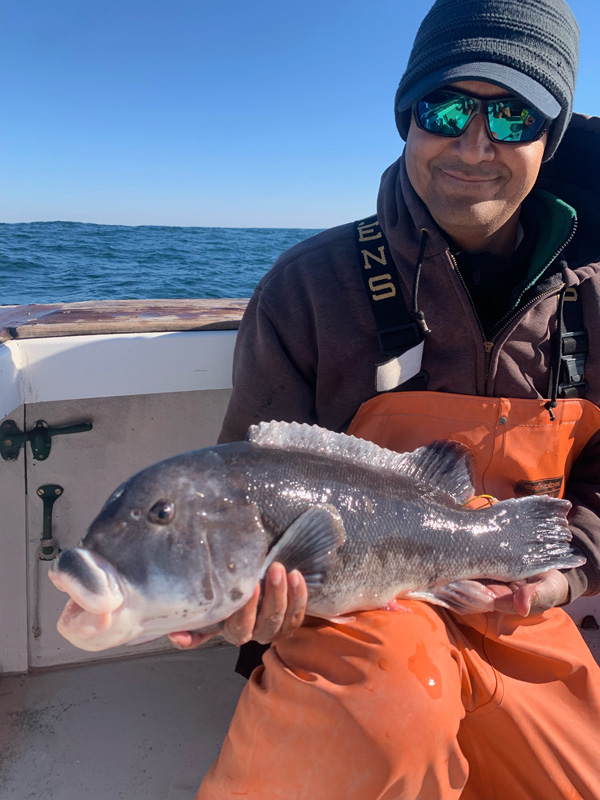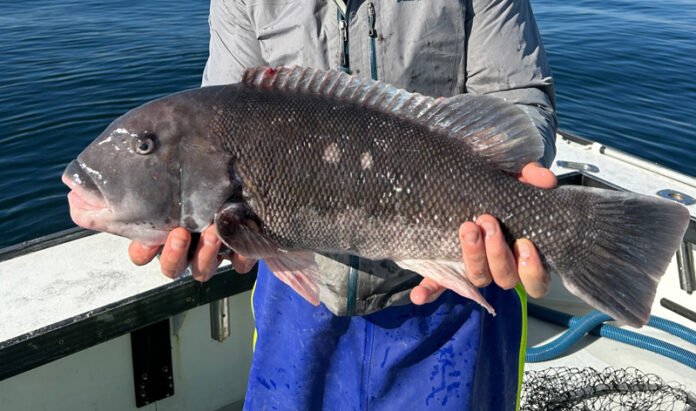Of the many varieties of fish that swim in the waters surrounding Martha’s Vineyard, one species holds a special place in the hearts of local anglers and chefs, yet often doesn’t get the recognition it deserves in either arena. Known in other parts of the East Coast as blackfish, the locally named “tautog” is nothing if not a rather funny-looking fish, with mottled black and gray flanks, huge rubbery lips and crazy buck teeth that look like an orthodontist’s nightmare. Perhaps that’s why tautog are often overshadowed by the more glamorous local species; they don’t have the sleek lines and vibrant colors of the iconic striped bass, nor the power and brilliance of tuna or swordfish, or even the splashes of turquoise found on black sea bass. Tautogs aren’t exactly ugly, but they do have a face only a mother (or fishmonger) could love. What they lack in aesthetics, however, they more than make up for in sporting ability (tautogs are challenging but fun to catch) and truly excellent table fare. Tautog season peaks in the autumn, after many other fish species have left local waters, and provide a terrific opportunity to enjoy one of our most delicious and versatile local species.
Tautog range from Nova Scotia to Georgia along the East Coast, and are almost always found near the bottom in rocky habitat, from boulder piles to jetties to underwater wrecks. This marked preference is due to their unique diets, as tautog seldom eat other fish or squid, instead prowling along the rocky bottom to feast on mussels, shrimp, barnacles, and — their favorite — crabs. This is where their funny-looking mouths come into play as an effective evolutionary trait, effortlessly munching through hard shells. Tautog even possess a second set of molar teeth, positioned like two crushing plates in the back of their throats that helps them pulverize even the toughest shellfish armor. Their stout, blunt shape, and an outer protective layer of mucus, lets them cruise through the gnarliest crags and rocky nooks, hidden from predators as they search for their next meal.
If there’s one universally agreed-upon fact about tautog, it’s that they are delicious. Their meat is white and very firm, with a delicate, sweet flavor that reflects their diet. The crabs, mussels, and other shellfish they devour result in delectable filets, and as tautog don’t eat other oily baitfish, they also don’t have any “fishiness.” Tautog have been referred to as “Poor Man’s Lobster” in cookbooks, sharing that nickname with monkfish and tilefish, two other crab-loving bottom dwellers. The firm texture of tautog filets have always given it preference as a chowder fish, as the chunks won’t overly flake and fall apart. But these qualities also give tautog great versatility in the kitchen, and the mild filets can be baked, poached, steamed, baked, broiled, even cooked in an air-fryer to great delight.


From the Mid-Atlantic to Rhode Island, tautog (or again, blackfish in those parts) are a hugely popular sport fish for anglers, often boats of all sizes are fishing for them throughout the fall and early winter. They can be caught from shore as well, as long as you’ve got the necessary rocky structure, a jetty, or even dock pilings. The very best bait to use is — no surprise — a whole or half crab. Tautog are also a very popular quarry for spearfishing as well.
The commercial catch is limited by season and strictly regulated catch quotas — every fish that goes to market is counted, and when a predetermined threshold is caught, the season is closed. Tautog are caught commercially primarily by rod and reel, and strict size limits ensure that these slow-growing fish have a healthy population in the future. The tautog fishery is a perfect example of local and sustainable delicious seafood, as it’s not a target of the large, industrial fishing fleets. Although there is an export market to New York and beyond for tautog, any tautog found in Vineyard restaurants or markets almost certainly came from local waters, caught by small-boat local Island fishermen.

“Oh, man, I love ‘em … they’re just champions,” says Johnny Hoy, when asked about tautog, adding his favorite way to cook them is “just about every which-way.” Along with his duties as frontman of the legendary Island blues band, Johnny Hoy and the Bluefish, and being herring warden of West Tisbury, Johnny finds time every fall to commercially harvest tautog from Island waters, bound for Island fish markets and restaurants. If you find tautog in an Island fish market, chances are good it was caught by Johnny. Every chance he gets during the season, he leaves from Menemsha and the rocky coastlines of Vineyard Sound, armed with several rods, a bucket of crabs for bait, and a loving respect for his quarry. “They’ll surprise you … they can be moody and funny … every new day you’ve got to crack the code to get ‘em to bite … they’re a worthy adversary,” Johnny said when I asked him about fishing for tautog. His passion for the pursuit of the funny-looking fish shines through our conversation, even more so once we start discussing tautog’s edibility and possibilities for preparation.
“Chefs like ‘em,” Hoy quipped, ”they come into season after the stripers move away, and their filets are kind of similar, nice and thick and white and easy to make delicious.” He shared a favorite recipe he adapted from Island Chef Albert Lattanzi, which calls for mixing fresh herbs, extra virgin olive oil, garlic, and capers together with a mortar and pestle and coating the tautog filets with the mixture. Then, over high heat, sear both sides, just about a minute each side. Reduce the heat to low, put a lid over the pan and let finish for another 4-5 minutes. “Don’t overcook!” cautions Hoy, and he promises a melt-in-your-mouth delight that’s perfect for the cool autumn and winter seasons.

I like to cook tautog the same way I do cod and haddock, putting the filets in a glass baking dish, coating them with melted butter and then a mixture of Panko breadcrumbs and crushed Ritz crackers. Bake at 375 for 15 minutes, or until the fish is white and opaque, and remove from the oven. Then turn on the broiler, and once hot, place the dish underneath for 15-20 seconds, just enough to lightly toast the topping. Add lemon wedges, and savor the sweet, mild flavors of a classic New England dish.
Of course, the old-timers were right about most things, including that tautog makes for awesome fish chowder. Making a base of fish stock is easy, and usually a single batch yields enough for several recipes, and can also be frozen for future use. After fileting, remove the gills from the heads, and place the rinsed heads and racks of bones into a stockpot and cover with water. Add an onion, celery and carrot, some peppercorns and a bay leaf, and bring just to boil. Reduce the heat to a simmer and let cook for 30 minutes, occasionally skimming off any foam. Unlike bone broths, fish stock doesn’t improve with longer cooking, so after a half hour, strain the stock through a cheesecloth or fine mesh sieve, and you have an unparalleled base for chowder. Many cooks, Johnny Hoy included, will add the chunks of tautog filets at the very end, turning off the heat while putting on a lid and letting the fish cook to a perfect doneness with the residual heat.
Tautog have a funny name and a downright goofy appearance, but are among the most delicious fish that swim in Vineyard waters. It’s a healthy and sustainable resource, and supports the local small-boat fleet that needs all the help it can get in the face of industrial overfishing and cheap imported seafood. Try venturing beyond the classic recipes, and you will discover the sublime flavor and great versatility of tautog — and one of the great culinary delights of autumn and winter in New England. Once you’ve tried tautog prepared a few different ways, that fish with the funny face and the big buck teeth might just begin to become beautiful.


